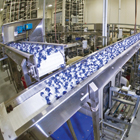
The Lindt USA plant in Stratham, N.H., has featured automatic wrapping for years, although electronics on the newer machines are more advanced. (Photo by Vito Palmisano)
Thomas Linemayr, president of Lindt USA, has said, “Premium is in our DNA-we’ve been doing nothing else for more than 160 years.”
That consumer demand and high standard of quality are also reflected in the European-flavored packaging production operations at the Lindt USA plant in Stratham, N.H. The output at the U.S. headquarters operations center on two products, truffles and chocolate bars.
“A lot of our technology comes from Europe because that’s where our first and main factory is located,” explains Manuel Wildberger, vice president of operations. “A lot of what we do is copy what is done in Switzerland in terms of the items that are produced, and we like to use the same type of equipment, too.”
For Lindor brand truffles, each of the four product lines boasts twoACMAdouble-twist wrappers. The eight wrappers, with each handling more than 1,000 truffles per minute, have been phased in since 1997, according to Wildberger. The most recent unit, installed in 2008, is only about 50 truffles per minute faster than the older units, Wildbeger points out. Although the mechanics are roughly similar, the electronics are more advanced, he adds, though they are in the process of upgrading the electronics on the older machines.
The wrapped truffles are collected in totes and staged for packaging into stand-up bags in a 100,000-square-foot packaging area in a separate building that was part of a $100 million investment in the facility. Packaging is done using preformed bags on one of five bag filler/sealers fromThürlings Verpackungsmaschinen GmbH. The preformed bags are open, filled and sealed at rates of up to 50 bags per minute. Each of the bag fillers is topped with a 24-headIshidacomputerized netweigher.
Some truffles are earmarked for bulk packs shipped to other Lindt plants, while others are manually packed into boxes, including small heart-shaped ones.
The bagged truffles are conveyed to two compact combination palletizers/stretch wrappers fromTopTier, added in early 2010. Before, these operations had been done manually. “We’re adding more automation in the packaging area when the volume requirement makes sense,” Wildberger says.
The second main packaging operations are for Lindt’s premium chocolate bars, which are wrapped by threeLoeschPackmachines installed in parallel. Chocolate bar production was added in summer 2009 as part of the recent expansion. The machines, which produce 100 to 125 bars per minute, offer automated roll changing.
The availability of the machines in left- and right-handed orientations meant that two of the machines could be paired together and run by one operator. “I’m very happy with these machines,” Wildberger says.
Lindt can produce about 16 different bar formats on the machines, ranging from Lindt Classic bars with inclusions such as hazelnuts to its super-thin Excellence products with up to 90% cocoa. The rest of the bar packaging and casing operations are done manually.
“We have several different bar formats and would need to standardize before we can further automate those operations,” Wildberger adds.
Even through the recession, Americans have indulged themselves with premium chocolate. “Consumers continue to buy and eat chocolate,” Wildberger says. “We’re still growing as a company and specifically in our North America operations.”
That’s good news for chocolate aficionados stateside.
-Rick Lingle, executive editor
To access our other 2010 Plants of the Year,click here.
